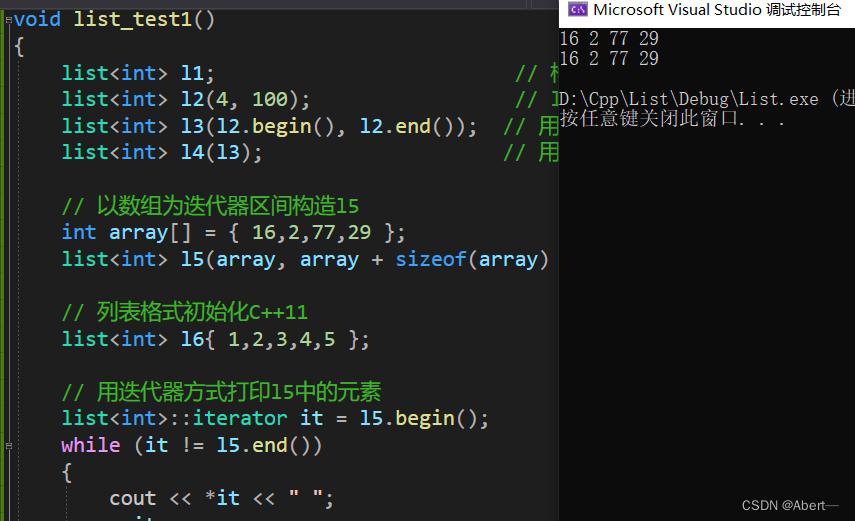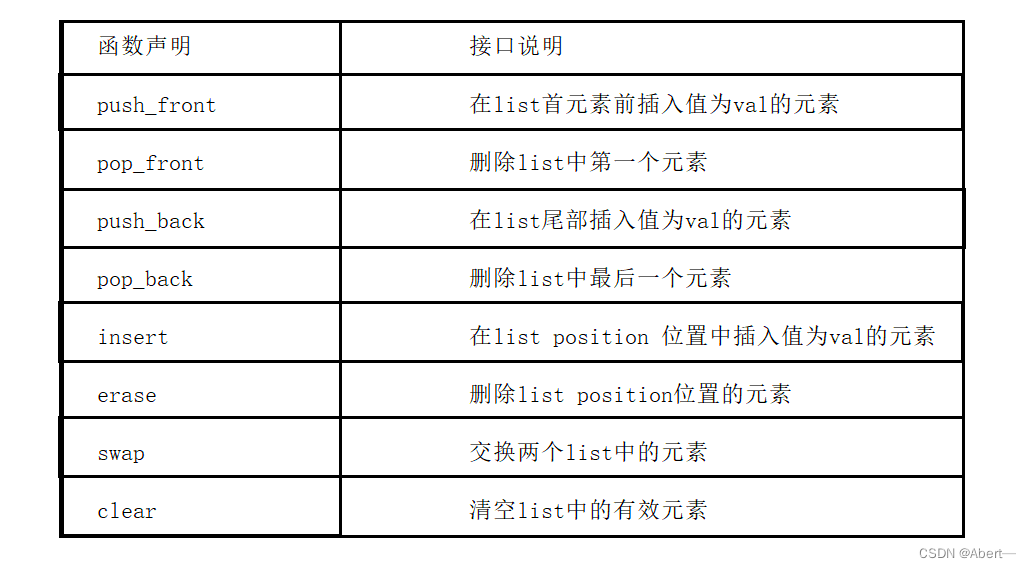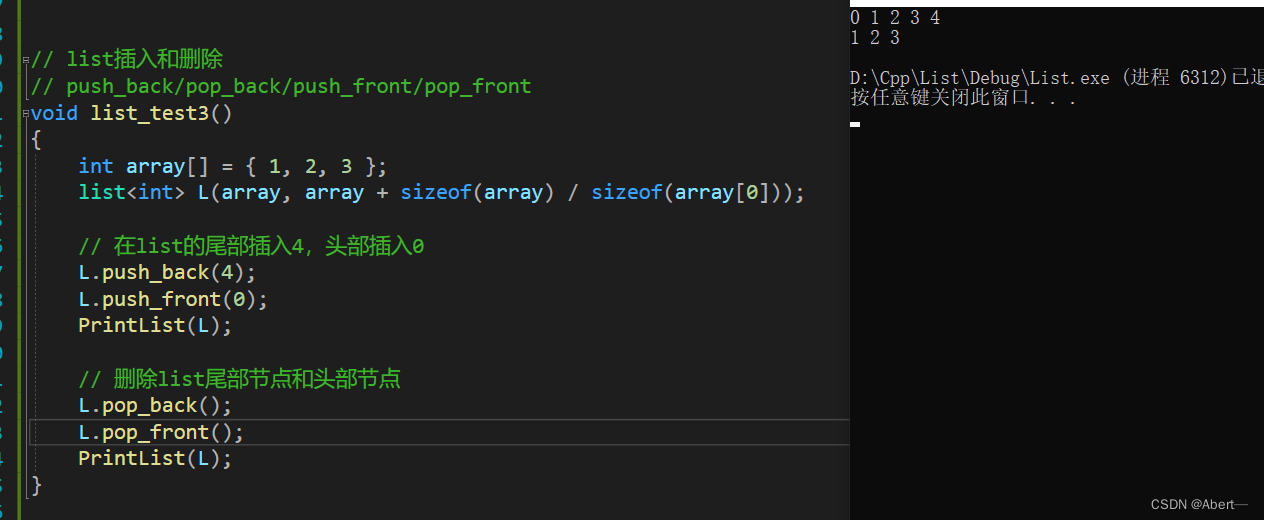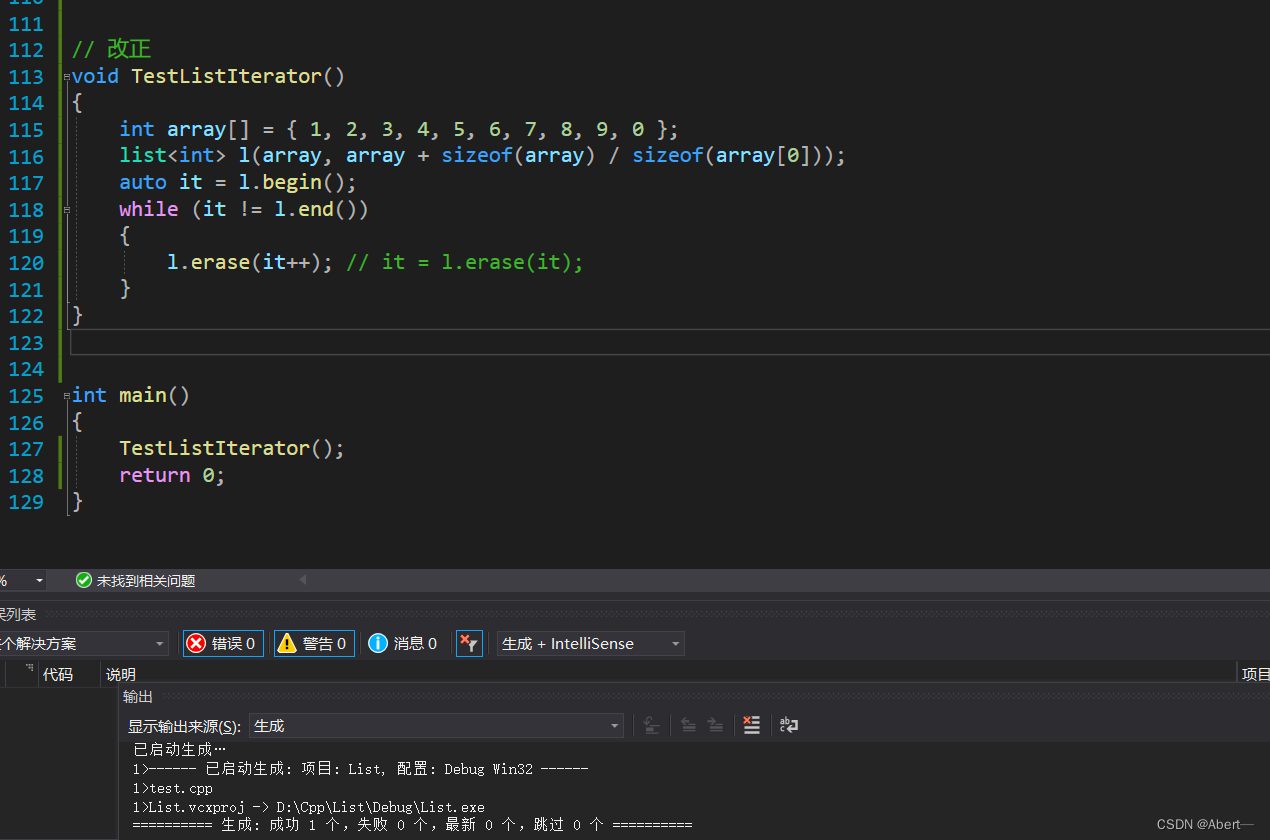list是可以在常数范围内在任意位置进行插入和删除的序列式容器,并且该容器可以前后双向迭代。
list的底层是双向链表结构,双向链表中每个元素存储在互不相关的独立节点中,在节点中通过指针指向其前一个元素和后一个元素。
list与forward_list非常相似:最主要的不同在于forward_list是单链表,只能朝前迭代,已让其更简单高效。
与其他的序列式容器相比(array,vector,deque),list通常在任意位置进行插入、移除元素的执行效率更好。
与其他序列式容器相比,list和forward_list最大的缺陷是不支持任意位置的随机访问,比如:要访问list的第6个元素,必须从已知的位置(比如头部或者尾部)迭代到该位置,在这段位置上迭代需要线性的时间开销;list还需要一些额外的空间,以保存每个节点的相关联信息(对于存储类型较小元素的大list来说这可能是一个重要的因素)
下面正式进入List的学习。
一、list结构剖析
list 是一个双向循环链表

结点类:
template<class T>
struct list_node // 节点
{
T _data;
list_node<T>* _next;
list_node<T>* _prev;
list_node(const T& x = T())
: _data(x)
, _next(nullptr)
, _prev(nullptr)
{}
};迭代器类:
template<class T, class Ref, class Ptr>
struct __list_iterator
{
typedef list_node<T> Node;
typedef __list_iterator<T, Ref, Ptr> iterator;
Node* _node;
//.....
};list 类:
template<class T>
class list
{
typedef list_node<T> Node;
public:
typedef __list_iterator<T, T&, T*> iterator;
typedef __list_iterator<T, const T&, const T*> const_iterator;
//......
private:
Node* _head;
};list类中包含上面两个类。
二、List 的使用
下面介绍list常用接口的使用。
2.1 list的构造

void list_test1()
{
list<int> l1; // 构造空的l1
list<int> l2(4, 100); // l2中放4个值为100的元素
list<int> l3(l2.begin(), l2.end()); // 用l2的[begin(), end())左闭右开的区间构造l3
list<int> l4(l3); // 用l3拷贝构造l4
// 以数组为迭代器区间构造l5
int array[] = { 16,2,77,29 };
list<int> l5(array, array + sizeof(array) / sizeof(int));
// 列表格式初始化C++11
list<int> l6{ 1,2,3,4,5 };
// 用迭代器方式打印l5中的元素
list<int>::iterator it = l5.begin();
while (it != l5.end())
{
cout << *it << " ";
++it;
}
cout << endl;
// C++11范围for的方式遍历
for (auto& e : l5)
cout << e << " ";
cout << endl;
} 
2.2 list iterator 的使用

1. begin与end为正向迭代器,对迭代器执行++操作,迭代器向后移动2. rbegin(end)与rend(begin)为反向迭代器,对迭代器执行++操作,迭代器向前移动
void list_test2()
{
int array[] = { 1, 2, 3, 4, 5, 6, 7, 8, 9, 0 };
list<int> l(array, array + sizeof(array) / sizeof(array[0]));
// 使用正向迭代器正向list中的元素
// list<int>::iterator it = l.begin(); // C++98中语法
auto it = l.begin(); // C++11之后推荐写法
while (it != l.end())
{
cout << *it << " ";
++it;
}
cout << endl;
// 使用反向迭代器逆向打印list中的元素
// list<int>::reverse_iterator rit = l.rbegin();
auto rit = l.rbegin();
while (rit != l.rend())
{
cout << *rit << " ";
++rit;
}
cout << endl;
} 
2.3 list capacity

2.4 list element access

2.5 list modififiers

void PrintList(const list<int>& l)
{
// 注意这里调用的是list的 begin() const,返回list的const_iterator对象
for (list<int>::const_iterator it = l.begin(); it != l.end(); ++it)
{
cout << *it << " ";
// *it = 10; 编译不通过
}
cout << endl;
}
// list插入和删除
// push_back/pop_back/push_front/pop_front
void list_test3()
{
int array[] = { 1, 2, 3 };
list<int> L(array, array + sizeof(array) / sizeof(array[0]));
// 在list的尾部插入4,头部插入0
L.push_back(4);
L.push_front(0);
PrintList(L);
// 删除list尾部节点和头部节点
L.pop_back();
L.pop_front();
PrintList(L);
} 
2.6 list的迭代器失效
迭代器失效即迭代器所指向的节点的无效,即该节点被删除了。因为list的底层结构为带头结点的双向循环链表,因此在list中进行插入时是不会导致list的迭代器失效的,只有在删除时才会失效,并且失效的只是指向被删除节点的迭代器,其他迭代器不会受到影响。
void TestListIterator1()
{
int array[] = { 1, 2, 3, 4, 5, 6, 7, 8, 9, 0 };
list<int> l(array, array + sizeof(array) / sizeof(array[0]));
auto it = l.begin();
while (it != l.end())
{
// erase()函数执行后,it所指向的节点已被删除,因此it无效,在下一次使用it时,必须先给其赋值
l.erase(it);
++it;
}
}
改正:
void TestListIterator()
{
int array[] = { 1, 2, 3, 4, 5, 6, 7, 8, 9, 0 };
list<int> l(array, array + sizeof(array) / sizeof(array[0]));
auto it = l.begin();
while (it != l.end())
{
l.erase(it++); // it = l.erase(it);
}
}
三、模拟实现list
list.h
#pragma once
#include <iostream>
#include <assert.h>
#include <algorithm>
#include <time.h>
using namespace std;
namespace Abert
{
template<class T>
struct list_node // 节点
{
T _data;
list_node<T>* _next;
list_node<T>* _prev;
list_node(const T& x = T())
: _data(x)
, _next(nullptr)
, _prev(nullptr)
{}
};
// 迭代器 像指针一样的对象
template<class T, class Ref, class Ptr>
struct __list_iterator
{
typedef list_node<T> Node;
typedef __list_iterator<T, Ref, Ptr> iterator;
Node* _node;
__list_iterator(Node* node)
:_node(node)
{}
bool operator!=(const iterator& it) const
{
return _node != it.node;
}
bool operator==(const iterator& it) const
{
return _node == it.node;
}
Ref operator*()
{
return _node->_data;
}
Ptr operator->()
{
return &(operator*());
}
// ++it
iterator operator++()
{
_node = _node->_next;
return *this;
}
// it++
iterator operator++(int)
{
iterator tmp(*this);
_node = _node->_next;
return tmp;
}
// --it
iterator operator--()
{
_node = _node->_prev;
return *this;
}
// it--
iterator operator--(int)
{
iterator tmp(*this);
_node = _node->_prev;
return tmp;
}
};
template<class T>
class list
{
typedef list_node<T> Node;
public:
typedef __list_iterator<T, T&, T*> iterator;
typedef __list_iterator<T, const T&, const T*> const_iterator;
const_iterator begin() const
{
return const_iterator(_head->_next);
}
const_iterator end() const
{
return const_iterator(_head);
}
iterator begin()
{
return const_iterator(_head->_next);
}
iterator end()
{
return const_iterator(_head);
}
void empty_init()
{
// 创建并初始化头节点
_head = new Node;
_head->_next = _head;
_head->_prev = _head;
}
template <class InputIterator>
list(InputIterator first, InputIterator last)
{
empty_init();
while (first != last)
{
push_back(*first);
++first;
}
}
list()
{
_head = new Node;
_head->next = _head;
_head->prev = _head;
}
void swap(list<T>& x)
{
std::swap(_head, x._head);
}
list(const list<T>& it)
{
empty_init();
list<T> tmp(it.begin, it.end);
swap(tmp);
}
list<T>& operator=(list<T> it)
{
swap(it);
return *this;
}
~list()
{
clear();
delete _head;
_head = nullptr;
}
void clear()
{
iterator it = begin;
while (it != end())
{
it = erase(it);
}
}
void push_back(const T& x)
{
/*Node* tail = head->_prev;
Node* newnode = new Node(x);
tail->_next = newnode;
newnode->_prev = tail;
newnode->_next = _head;
head->_prev = newnode;*/
insert(end(), x);
}
void push_front(const T& x)
{
insert(begin(), x);
}
iterator insert(iterator pos, const T& x)
{
Node* cur = pos.node;
Node* prev = cur->prev;
Node* newnode = new Node(x);
cur->_prev = newnode;
newnode->_next = cur;
prev->_next = newnode;
newnode->_prev = prev;
return iterator(newnode);
}
void pop_back()
{
erase(end());
}
void pop_front()
{
erase(begin());
}
iterator erase(iterator pos)
{
assert(pos != end());
Node* cur = pos.node;
Node* prev = cur->_prev;
Node* next = cur->_next;
prev->_next = next;
next->_prev = prev;
delete cur;
return iterator(next);
}
private:
Node* _head;
};
}list 的反向迭代器
ReverseListIterator.h
#pragma once
#include "list.h"
template<class Iterator>
class ReverseListIterator
{
// 注意:此处typename的作用是明确告诉编译器,Ref是Iterator类中的类型,而不是静态成员变量
// 否则编译器编译时就不知道Ref是Iterator中的类型还是静态成员变量
// 因为静态成员变量也是按照 类名::静态成员变量名 的方式访问的
public:
typedef typename Iterator::Ref Ref;
typedef typename Iterator::Ptr Ptr;
typedef ReverseListIterator<Iterator> Self;
public:
//
// 构造
ReverseListIterator(Iterator it) : _it(it) {}
//
// 具有指针类似行为
Ref operator*() {
Iterator temp(_it);
--temp;
return *temp;
}
Ptr operator->() { return &(operator*()); }
//
// 迭代器支持移动
Self& operator++() {
--_it;
return *this;
}
Self operator++(int) {
Self temp(*this);
--_it;
return temp;
}
Self& operator--() {
++_it;
return *this;
}
Self operator--(int)
{
Self temp(*this);
++_it;
return temp;
}
//
// 迭代器支持比较
bool operator!=(const Self& l)const { return _it != l._it; }
bool operator==(const Self& l)const { return _it != l._it; }
Iterator _it;
};四、vector 与 list 的比较
vector与list都是STL中非常重要的序列式容器,由于两个容器的底层结构不同,导致其特性以及应用场景不同,其主要不同如下:

以上就是本文的全部内容,欢迎大家学习交流。





















 1488
1488











 被折叠的 条评论
为什么被折叠?
被折叠的 条评论
为什么被折叠?








